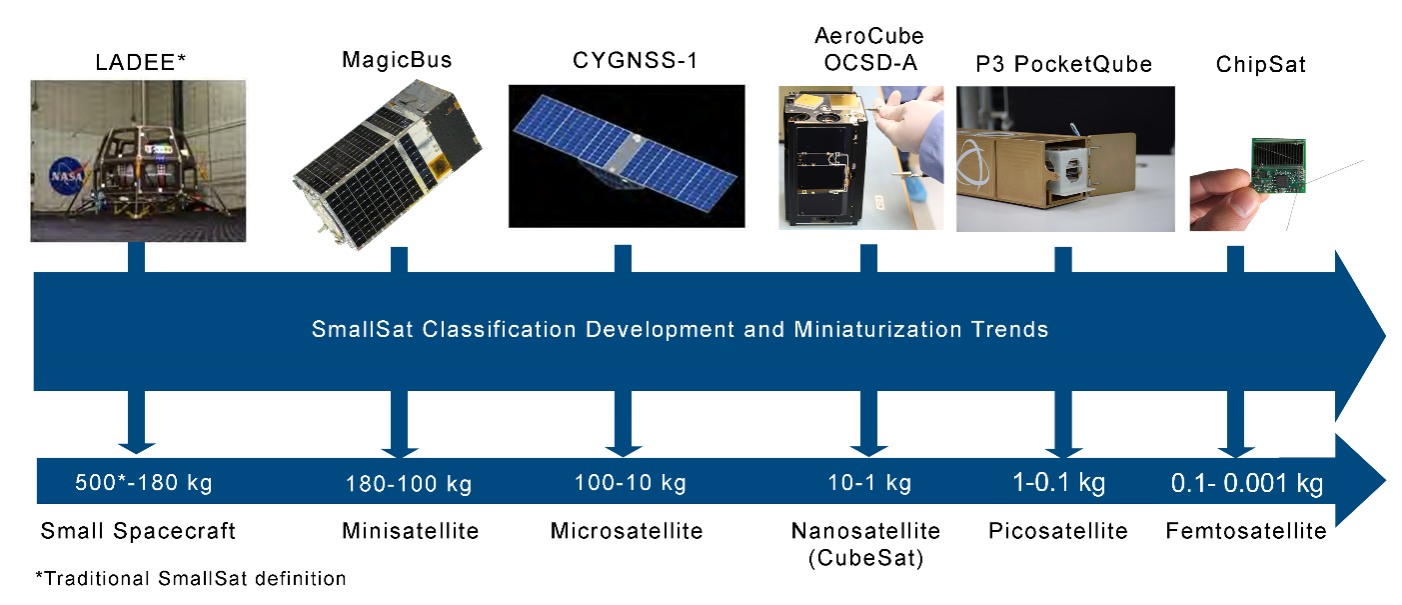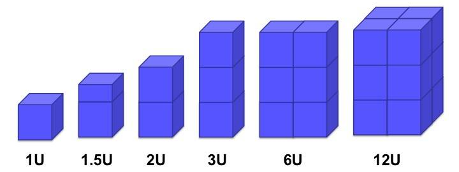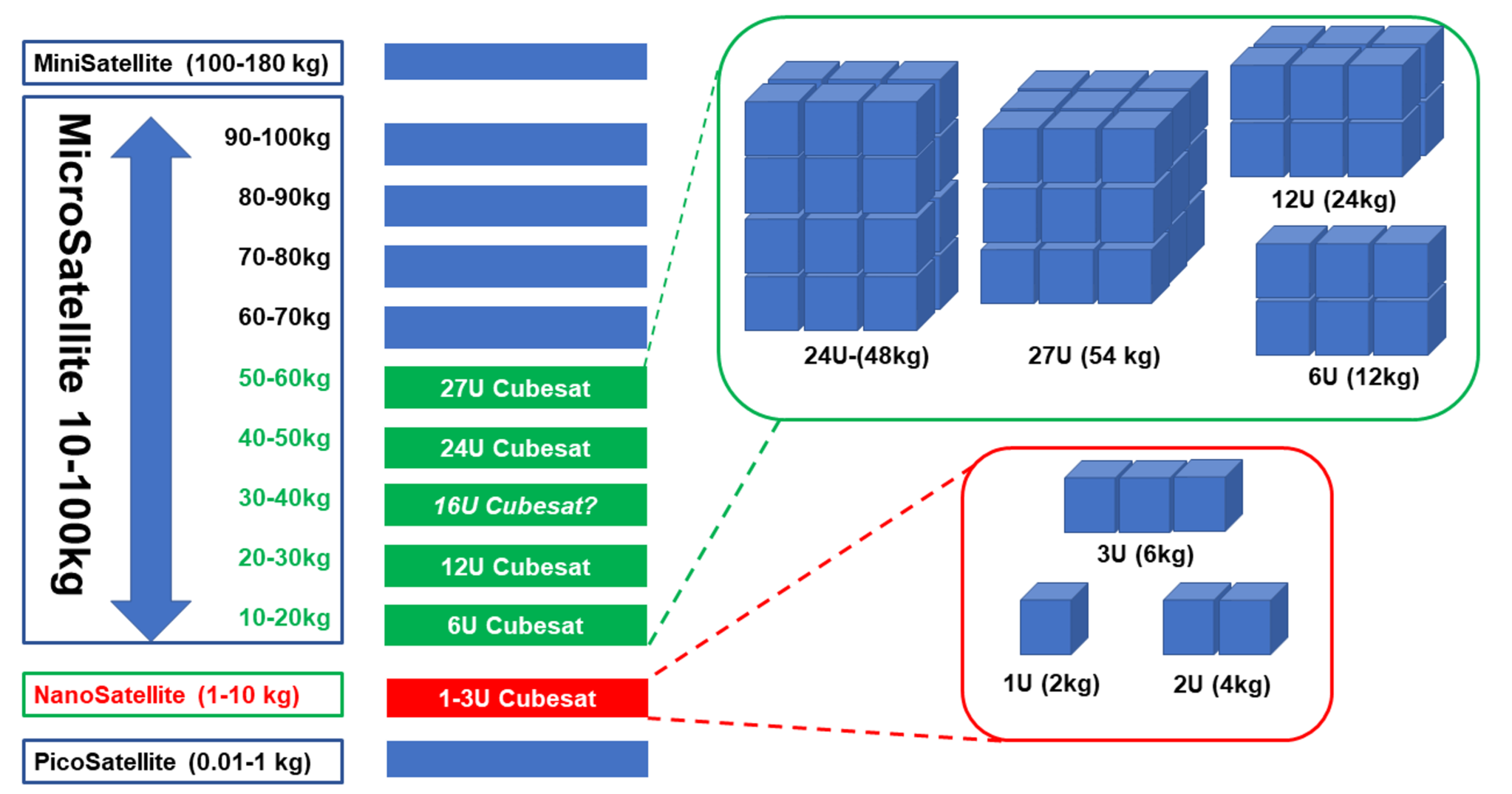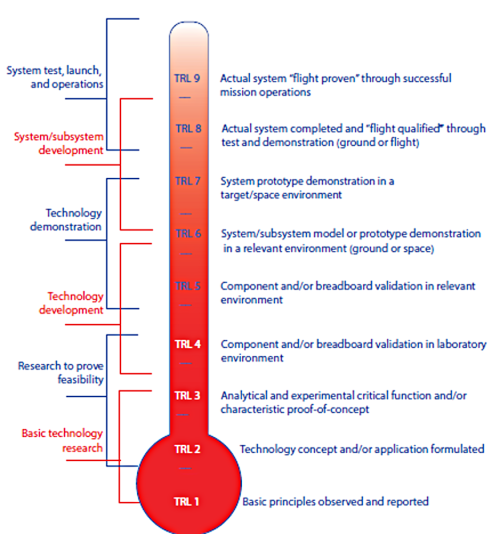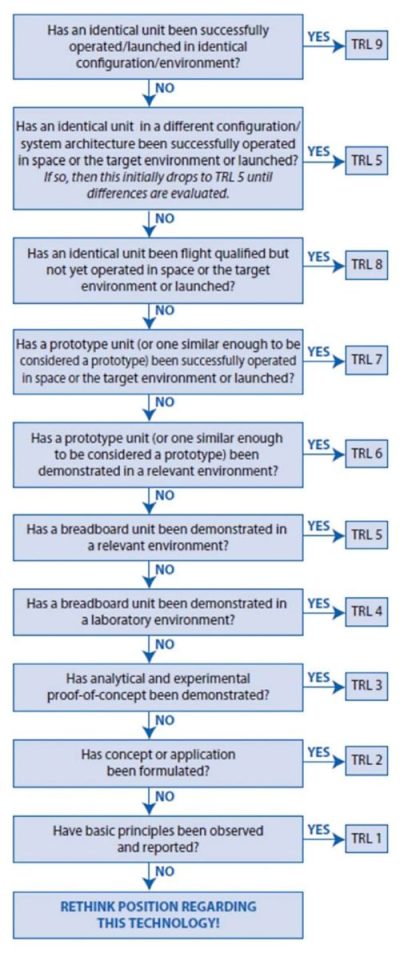Chapter Glossary
| (EELV) | Evolved Expendable Launch Vehicle |
| (ESPA) | EELV Secondary Payload Adapter |
| (FASTSAT) | Fast, Affordable, Science and Technology Satellite |
| (LADEE) | Lunar Atmosphere and Dust Environment Explorer |
| (LCROSS) | Lunar Crater Observation and Sensing Satellite |
| (NODIS) | NASA Online Directives Information System |
| (SST) | Small Spacecraft Technology |
| (STMD) | Space Technology Mission Directorate |
| (TMA) | Technology Maturity Assessment |
| (TRL) | Technology Readiness Level |
| (U) | Unit |
1.1 Objective
The objective of this report is to assess and provide an overview of the state of the art in small spacecraft technologies for use by mission designers, project managers, technologists, and students, connecting current small spacecraft missions to available technologies. This report focuses on the spacecraft system in its entirety, provides current best practices for integration and key considerations for the reader where possible, and presents devices from publicly available sources for each specific spacecraft subsystem.
This report is a survey of small spacecraft technologies sourced from open literature; it is not an original source. In addition, this report only considers literature in the public domain. Information presented in this report is limited to SmallSat technology that is publicly available as of September 30, 2024. It does not include information on instrumentation, science payloads, or advances or developments that have not been publicly disclosed. Commonly used sources for data include manufacturer datasheets, press releases, conference papers, journal papers, public filings with government agencies, news articles, presentations, the compendium of databases accessed via NASA’s Small Spacecraft Systems Virtual Institute (S3VI) Information Search, and engagement with companies. Data not appropriate for public dissemination, such as proprietary, export controlled, or otherwise restricted data, are not considered. We encourage the SmallSat community to publish mission outcomes and technology development milestones in publicly available conference papers, press releases, or company websites so they can be reflected in future editions of this report.
This report is funded by NASA’s Space Technology Mission Directorate (STMD). It was first commissioned by the Small Spacecraft Technology (SST) program within NASA’s STMD in mid-2012 in response to the rapid growth in interest in using small spacecraft for low-Earth orbit, low-cost missions. The report was subsequently updated in 2015, 2018, 2020, 2021, 2022, and 2023 to capture SmallSat technology growth and maturation. In addition to reporting currently available state-of-the-art technologies that have achieved Technology Readiness Level (TRL) 5 or above, a prognosis is provided describing technologies as “on the horizon” if they are being considered for future application.
1.2 Scope
The NASA-SmallSat era began at NASA Ames Research Center with the launch of Pioneer 10 and 11 in March 1972 and April 1973, respectively, where both spacecraft weighed < 600 kg. The NASA SmallSat mission gained momentum when NASA initiated the Small Explorer (SMEX) program in 1988 to encourage the development of small spacecraft with masses in the range of ~60–350 kg to reduce cost. In 1998 NASA Ames focused its SmallSat program on lunar exploration and launched Lunar Prospector (< 700 kg), followed by the Lunar Crater Observation and Sensing Satellite (LCROSS), (< 630 kg) in 2009, and the Lunar Atmosphere and Dust Environment Explorer (LADEE), (~380 kg) which was launched in September 2013. In late 2010, NASA launched its first minisatellite called Fast, Affordable, Science and Technology Satellite (FASTSAT), which had a launch mass ~180 kg. This decrease in spacecraft mass, reduced overall cost, and increase in science capabilities ignited interest in miniaturization and maturity of aerospace technologies which have proven to be capable of producing more complex missions for less cost.
In 2012, the Evolved Expendable Launch Vehicle (EELV) Secondary Payload Adapter (ESPA) provided a modular packaging approach for six payload slots of up to 180 kg mass allocation. As this report is focused on smaller platforms, the “180 kg mass limit” served as a convenient metric to further classify the maximum “SmallSat” mass. SmallSats are generally grouped according to their mass, and this report adopts the following five small spacecraft mass categories (1):
- minisatellites are spacecraft with a total mass of 100 – 180 kg;
- microsatellites have a total spacecraft mass of 10 – 100 kg;
- nanosatellites have a total mass of 1 – 10 kg;
- picosatellites have a mass of 1 – 0.01 kg; and
- femtosatellites have a total spacecraft mass 0.01 – 0.09 kg.
Figure 1.1 offers examples of spacecraft categorized by mass. On the lower mass end, there are projects such as KickSat-2, which deployed 100-centimeter (cm) scale “ChipSat” spacecraft, or Sprites, from a 2U femtosatellite deployer in March 2019. These femtosatellite ChipSats are the size of a large postage stamp and have a mass below 10 grams.
In 1999, a collaboration between California Polytechnic State University (Cal Poly) in San Luis Obispo and Stanford University in Stanford, California, developed a small educational platform called a “CubeSat” which was designed for academic space exploration and research. CubeSats are now a common form of small spacecraft that can weigh only a few kilograms and are based on a form factor of a 10 cm square cube, or unit (U) (1). While the original CubeSat was composed of a single 1U cube, in 2014 the CubeSat form factor expanded to 6U, and it is now common to combine multiple cubes to form larger units, as shown in Figure 1.2. These larger CubeSat sizes have become more standardized and popular in the past few years as much more science can be achieved at less cost with the additional volume, power, and overall increase in capability.
It is common to interchange the terms “CubeSat” and “NanoSat” (short for nanosatellite) as the original 1-3U CubeSat platforms fell under the nanosatellite category. Since the physical expansion of CubeSats now goes beyond the 6U form factor, CubeSats fall into both nanosatellite and microsatellite categories. Certain chapters of this report have a particular emphasis on CubeSat platforms as nanosatellite applications have expanded in recent years. Figure 1.3 illustrates the three smaller SmallSat categories: microsatellites, nanosatellites, and picosatellites.
1.3 Assessment
A central element of this report is to list state-of-the-art technologies by NASA standard Technology Readiness Level (TRL) as defined by the 2020 NASA Engineering Handbook, found in NASA NPR 7123.1C NASA Systems Engineering Processes and Requirements. The authors have endeavored to independently verify the TRL value of each technology by reviewing and citing published test results or publicly available data to the best of their ability. Where test results and data disagree with vendors’ own advertised TRL, the authors have attempted to engage the vendors to discuss the discrepancy. Readers are strongly encouraged to follow the references cited in the literature describing the full performance range and capabilities of each technology. Readers of this report should contact individual companies to further clarify information. It is important to note that this report takes a broad system-level view. To attain a high TRL, the subsystem must be in a flight-ready configuration with all supporting infrastructure—such as mounting points, power conversion, and control algorithms—in an integrated unit.
While “state-of-the-art” may be defined as the most recent development stage of technology, this report defines “state-of-the-art” in the context of NASA’s TRL scale (Figure 1.4) when assessing SmallSat technology. A technology may be deemed state-of-the-art whenever its TRL is larger than or equal to 5. A TRL of 5 indicates that the component and/or brassboard with realistic support elements was built and operated for validation in a relevant environment so as to demonstrate overall performance in critical areas. Success criteria include documented test performance demonstrating agreement with analytical predictions and documented definition of scaling requirements. Performance predictions are made for subsequent development phases (2).
An accurate TRL assessment requires a high degree of technical knowledge on a subject device, and an in-depth understanding of the mission (including interfaces and environment) on which the device was flown. TRL values vary depending on design factors for a specific technology. For example, differences in TRL assessment based on the operating environment may result from mechanical loads, mission duration, the thermal environment, or radiation exposure. The authors believe TRLs are most accurately determined when assessed within the context of a program’s unique requirements. If a technology has flown on a mission without success, or without providing valid confirmation to the operator, such claimed “flight heritage” is discounted. Some older technologies may still be well suited to certain mission needs and still be regarded as “state-of-the-art.” For a technology to be considered obsolete, “retired”, or no longer “state-of-the-art”, it’s performance must have been surpassed by newer technology such that it is no longer used.
While a technology with a TRL value lower than or equal to 4 may not be state of the art, in some cases these technologies may considered “on the horizon.” A TRL of 4 is defined as a component and/or breadboard validated in a laboratory environment with documented test performance demonstrating agreement with analytical predictions and a documented definition of the relevant environment. These promising technologies may soon be considered state-of-the-art for small spacecraft.
NASA standard TRL requirements for this report edition are stated in the NPR 7123.1C, Appendix E, which is effective through February 14, 2025. The criteria for selection of appropriate TRL are described in the NASA Systems Engineering Handbook 6105 Rev 2 Appendix G: Technology Assessment/Insertion. Please refer to the NASA Online Directives Information System (NODIS) website https://nodis3.gsfc.nasa.gov/ for NPR documentation. The following paragraphs in sections 1.3.1 and 1.3.2 of this Introduction are excerpts from the NASA Engineering Handbook 6105 Rev 2 (pp. 252 – 254). They highlight important aspects of NASA TRL guidelines in hopes of eliminating confusion on terminology and heritage systems.
1.3.1 Terminology
“At first glance, the TRL descriptions in Figure 1.4 appear to be straightforward. It is in the process of trying to assign levels that problems arise. A primary cause of difficulty is in terminology, e.g., everyone knows what a breadboard is, but not everyone has the same definition. Also, what is a “relevant environment?” What is relevant to one application may or may not be relevant to another. Many of these terms originated in various branches of engineering and had, at the time, very specific meanings to that particular field. They have since become commonly used throughout the engineering field and often acquire differences in meaning from discipline to discipline, some differences subtle, some not so subtle. “Breadboard,” for example, comes from electrical engineering where the original use referred to checking out the functional design of an electrical circuit by populating a “breadboard” with components to verify that the design operated as anticipated. Other terms come from mechanical engineering, referring primarily to units that are subjected to different levels of stress under testing, e.g., qualification, protoflight, and flight units. The first step in developing a uniform TRL assessment (see Figure 1.5) is to define the terms used. It is extremely important to develop and use a consistent set of definitions over the course of the program/project.”
1.3.2 Heritage Systems
“Note the second box particularly refers to heritage systems (Figure 1.5). If the architecture and the environment have changed, then the TRL decreases to TRL 5—at least initially. Additional testing may need to be done for heritage systems for the new use or new environment. If in subsequent analysis the new environment is sufficiently close to the old environment or the new architecture is sufficiently close to the old architecture, then the resulting evaluation could be TRL 6 or 7, but the most important thing to realize is that it is no longer at TRL 9. Applying this process at the system level and then proceeding to lower levels of subsystems and components identifies those elements that require development and sets the stage for the subsequent phase, determining the new TRL.”
References
- NASA. What are SmallSats and CubeSats? February 26, 2015. Revised August 6, 2017. https://www.nasa.gov/content/what-are-smallsats-and-cubesats
- NASA Systems Engineering Handbook. NASA/SP-2016 6105 Rev. 2. https://www.nasa.gov/feature/release-of-revision-to-the-nasa-systems-engineering-handbook-sp-2016-6105-rev-2




























